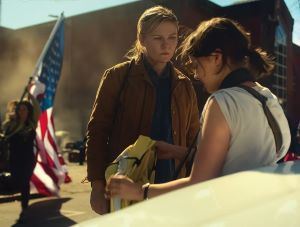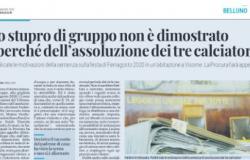Of Sandro Moiso
– Who are you?
– We are American.
– Yes, what kind of Americans? (Civil War2024)
Everything is contained in this very short dialogue, contained in one of the most dramatic scenes of the film written and directed by the British Alex Garland (born in 1970), not only the meaning of one of the most intense cinematographic works of recent times, but also of the divisions that have precipitated the heart of the Western empire into the civil war represented on the screen and which, even in reality, smolders under the ashes of what remains of theAmerican Dream.
A film that has already caused discussion and which in a political and cultural panorama as suffocated as the Italian one, divided between cinematic intimacy too often disguised as civil commitment and the bland “anti-fascist” debate on censorship to the even more insipid monologue of those who would posing as a new Matteotti, literally explodes on the screen and in the spectator’s gaze. With a strength and virulence far from any product of our vacuous and respectable intelligentsia.
Alexander Medawar Garland, novel writer and former screenwriter of 28 days later (28 Days Later, 2002) by Danny Boyle, is not the first time that he brings to the screen the possible consequences of a violence that has long been repressed and denied which can, however, turn into an authentic internal war in societies that believe they are more advanced and liberal. But the theme of the work that gave him fame as a screenwriter was still connected to a context of a roughly science fiction and anticipatory nature, Civil War it essentially speaks to us about the here and now.
The journey of the veteran war photojournalist Lee, of the two journalists Joel and Sammy and of the aspiring and immature photojournalist Jessie, is not a journey into a dystopian future, but plunges the viewer into the contradictions of a latent civil war already visible today, for the most attentive observers, in the folds of a society born from a civil war that has never been completely resolved and which for years has returned to present itself as an inevitable historical necessity1.
 There are 758 miles that separate New York, the starting point of the team of reporters, from Washington, the scheduled arrival point for a final and uncertain interview with a President of the United States fiercely clinging to power, but now surrounded by the troops of the Front Western, of the alliance between Texas and California (the two largest states of the Union), which maintained the red and white stripes of the national flag but reduced the stars to two, and of the Florida Alliance.
There are 758 miles that separate New York, the starting point of the team of reporters, from Washington, the scheduled arrival point for a final and uncertain interview with a President of the United States fiercely clinging to power, but now surrounded by the troops of the Front Western, of the alliance between Texas and California (the two largest states of the Union), which maintained the red and white stripes of the national flag but reduced the stars to two, and of the Florida Alliance.
New York is shocked by protests over the miserable living conditions and suicide attacks by the most desperate of the tent cities that have developed in the streets of the former Big Apple, modeled on the current and real ones in Los Angeles. So the journey, for reasons of convenience, will first head west and then return east towards Charlottesville in Virginia. That Virginia which, in 1862, during the “historic” civil war saw an important victory for the secessionist armies of the South and which from there, under the leadership of General Lee, decided to cross the Potomac to march on Washington.
 It is a landscape of highways full of destroyed and abandoned civilian and military vehicles, of shopping centers that have become war zones and of refugee camps organized in stadiums; of cruelty of all kinds carried out by one party against the other, even if it is well understood that there are much more than two parties at play, often animated by different motivations yet guided by the same ferocity. Of corpses abandoned in parking lots mall or in mass graves and sprinkled with lime or with tortured bodies, humiliated and offended in every way, hanging from overpasses if not in car washes. Of cold-blooded killings after summary interrogations or without even the need for them: the Land of the Free is photographed, literally, in all its possible barbarity, while Suicide’s music, from RocketUSA to Dream Baby Dreamserves very well as a viaticum for the undertaking2.
It is a landscape of highways full of destroyed and abandoned civilian and military vehicles, of shopping centers that have become war zones and of refugee camps organized in stadiums; of cruelty of all kinds carried out by one party against the other, even if it is well understood that there are much more than two parties at play, often animated by different motivations yet guided by the same ferocity. Of corpses abandoned in parking lots mall or in mass graves and sprinkled with lime or with tortured bodies, humiliated and offended in every way, hanging from overpasses if not in car washes. Of cold-blooded killings after summary interrogations or without even the need for them: the Land of the Free is photographed, literally, in all its possible barbarity, while Suicide’s music, from RocketUSA to Dream Baby Dreamserves very well as a viaticum for the undertaking2.
 It is as if the war and violence exported for decades by the Western empire to the rest of the world, often in the guise of coups d’état and civil wars, had decided to return to the maternal womb, to devour the mother’s body from the inside . Yet, even if snipers with painted nails appear here and there, the Hawaiian shirts of the Boogaloo Boys or the exalted looks that recall the attackers of Capitol Hill, it is not the local militias or the “homemade” weapons that determine the role play, but armed forces well trained for the task of killing and destroying, equipped with an arsenal and firepower that includes heavy weapons, tanks, helicopters, armored Humvees and all other types.
It is as if the war and violence exported for decades by the Western empire to the rest of the world, often in the guise of coups d’état and civil wars, had decided to return to the maternal womb, to devour the mother’s body from the inside . Yet, even if snipers with painted nails appear here and there, the Hawaiian shirts of the Boogaloo Boys or the exalted looks that recall the attackers of Capitol Hill, it is not the local militias or the “homemade” weapons that determine the role play, but armed forces well trained for the task of killing and destroying, equipped with an arsenal and firepower that includes heavy weapons, tanks, helicopters, armored Humvees and all other types.
The army has evidently disintegrated like the National Guard, but the war machine and its armaments have remained well oiled and functioning and so, while the last loyalist troops defend Washington and the president repeatedly announces, as is necessary even in these days to regarding Ukraine and the Middle East, the next historic victory of the forces of good, everything is destroyed or violated, together with the last defenses, the Lincoln Memorial and the White House itself.
 The violence unfolded is far more terrible than that imagined at the time of the films that predicted Soviet and North Korean invasions of the United States, such as Red Dawn (Red Dawn, 1984) by John Milius. Forty years have not passed in vain, neither in the real history of the decline of the empire nor, much less, for the American cinematographic imagination which often, even where it does not dare to talk about the possible civil war that awaits the empire, certainly does not dampen the tones of criticism of imperial domination over the rest of the world, both in television series and, in a manner mediated by epic science fiction, in productions such as Dunes I and II by Canadian Denis Villeneuve.
The violence unfolded is far more terrible than that imagined at the time of the films that predicted Soviet and North Korean invasions of the United States, such as Red Dawn (Red Dawn, 1984) by John Milius. Forty years have not passed in vain, neither in the real history of the decline of the empire nor, much less, for the American cinematographic imagination which often, even where it does not dare to talk about the possible civil war that awaits the empire, certainly does not dampen the tones of criticism of imperial domination over the rest of the world, both in television series and, in a manner mediated by epic science fiction, in productions such as Dunes I and II by Canadian Denis Villeneuve.
The film does not tell us which camp the president belongs to, whether Republican or Democrat, after all it is not necessary, even if certainly many well-thinking local critics and many of the public would have preferred a more defined situation, to be able to at least side with one of the two parties involved. But what really matters is that the American dollar has lost its value and that life can only be considered normal once the normality of war is accepted.
 Anglo-American production is serious. He knows that a civil war of such proportions is not the product of a simple and rhetorical battle between democracy and authoritarianism or attributable to a “class struggle” reduced to theater between two easily recognizable and “pure” classes in conflict: bourgeoisie and proletariat. As already stated in a text from a few years ago, the category of civil war can in fact constitute:
Anglo-American production is serious. He knows that a civil war of such proportions is not the product of a simple and rhetorical battle between democracy and authoritarianism or attributable to a “class struggle” reduced to theater between two easily recognizable and “pure” classes in conflict: bourgeoisie and proletariat. As already stated in a text from a few years ago, the category of civil war can in fact constitute:
a more adequate element for the interpretation of a set of social contradictions and struggles that have manifested themselves at an international level with a certain frequency and intensity over the last few years, whose organizational and purpose heterogeneity can still hardly be confined solely within the more traditional, and perhaps reductive, formula of class struggle or war. Contradictions on the social, economic and environmental level acted out by multiple actors, to which the States, regardless of their geopolitical position, have almost always given repressive and authoritarian responses3.
But it could find its final point of expression precisely in the United States, as Garland’s film indicates. Even if it is not only Garland who suggests it, but also various careful studies on the American reality4.
 Leaving aside, for now, the more obviously political and sociological content of the film, as well as underlining the essential nature of directing a medium-cost film and the skill of the performers and actors, from Kirsten Dunst (Lee), Wagner Moura (Joel) , Stephen McKinley Henderson (Sammy), Cailee Spaeny (Jessie) up to Jesse Piemons (in the role of an ultranationalist soldier), what still needs to be underlined here is another important aspect of the events narrated.
Leaving aside, for now, the more obviously political and sociological content of the film, as well as underlining the essential nature of directing a medium-cost film and the skill of the performers and actors, from Kirsten Dunst (Lee), Wagner Moura (Joel) , Stephen McKinley Henderson (Sammy), Cailee Spaeny (Jessie) up to Jesse Piemons (in the role of an ultranationalist soldier), what still needs to be underlined here is another important aspect of the events narrated.
This is the difference between photographing the reality of war or describing it in an article. The difference between the gaze and the word and the different connection between the eye and the mind compared to that between the ability to write and the reflection necessary to implement it. The first action is immediate and cannot afford the luxury of mediation, while the second makes the capacity for interpretative mediation its strong point. In other words: the reporter, if he wants, can re-invent the war, removing what could hurt him the most, while the photojournalist must necessarily accept the most painful aspects of it, otherwise he will fail to fulfill his role.
 This simple and immediate consideration seems to be reflected in the character of the characters, in their choices and in their destiny. Apparently more cynical and detached, the older photojournalist appears, fully capable, however, of transmitting to her young “heir” the ability to capture the moment through the shot, whatever the costs on both a physical and emotional level. A dirty profession in which the “fleeting moment” is everything and requires knowing how to disconnect sensitivity from the disposition to act automatically through the camera, even at the cost of losing one’s humanity, precisely to convey to the general public the inhumanity of every war. Or keep it within oneself, until being torn apart by it, as happens to Lee, who precisely by virtue of this is, however, still the only one capable of an extreme gesture.
This simple and immediate consideration seems to be reflected in the character of the characters, in their choices and in their destiny. Apparently more cynical and detached, the older photojournalist appears, fully capable, however, of transmitting to her young “heir” the ability to capture the moment through the shot, whatever the costs on both a physical and emotional level. A dirty profession in which the “fleeting moment” is everything and requires knowing how to disconnect sensitivity from the disposition to act automatically through the camera, even at the cost of losing one’s humanity, precisely to convey to the general public the inhumanity of every war. Or keep it within oneself, until being torn apart by it, as happens to Lee, who precisely by virtue of this is, however, still the only one capable of an extreme gesture.
 While the journalist can still take time to narrate the facts through the mediation of writing. Traveling, on the battlefield or in one of those hotels for journalists typical of war zones which in the film, at least for once, are no longer just in the Middle East, Asia, Africa or on the eastern borders of Europe, but in a New York in which the attack on the twin towers on 11 September 2001 seems to constitute, more than a warning or a warning, only a pale memory, while the crater of Ground Zero it seems to have really swallowed everything definitively.
While the journalist can still take time to narrate the facts through the mediation of writing. Traveling, on the battlefield or in one of those hotels for journalists typical of war zones which in the film, at least for once, are no longer just in the Middle East, Asia, Africa or on the eastern borders of Europe, but in a New York in which the attack on the twin towers on 11 September 2001 seems to constitute, more than a warning or a warning, only a pale memory, while the crater of Ground Zero it seems to have really swallowed everything definitively.














